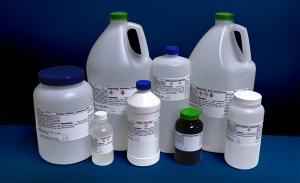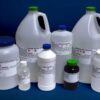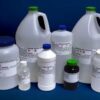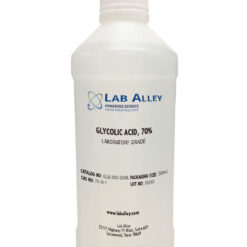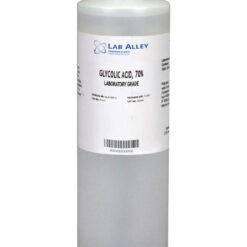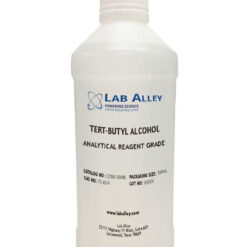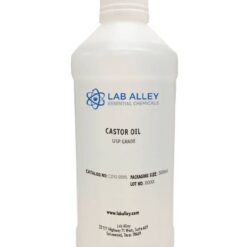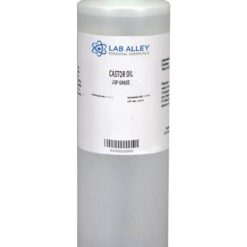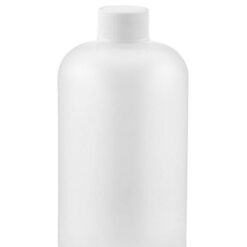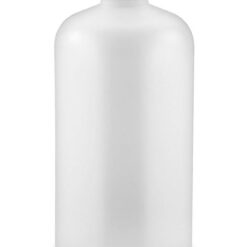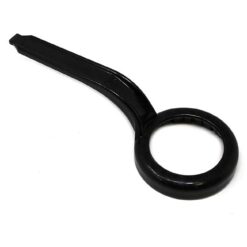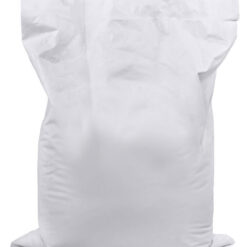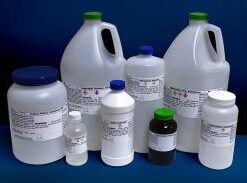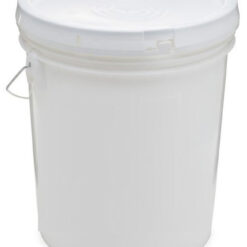Stannous Chloride Crystals, Lab Grade
$29.00 – $1,586.00
| 10025-69-1 | |
| SnCl2-2H2O | |
| 225.65 | |
| 1759 |
Stannous Chloride, also known as Dichlorotin, Tin(II) Chloride, and Tin Dichloride, has the chemical formula SnCl2. Its anhydrous form appears as colorless to white hygroscopic crystalline mass or flaky solid with a fatty appearance and no odor. It is sparingly soluble in excess Water and freely soluble in Alcohol at ambient conditions. Normally, its anhydrous salt is produced by direct reaction of chlorine and molten Tin or by heating Tin in Hydrogen Chloride gas. Chemically pure or Laboratory reagents are the two terms often used to describe Lab Grade chemicals. Lab Grade chemicals do not meet any accepted quality or purity requirements such as the ACS Grade, the USP Grade, and the FCC Grade, despite their acceptable purity. In the United States of America (USA), Lab Alley is selling its high-quality Stannous Chloride, Anhydrous, Lab Grade online at laballey.com. Due to its high purity, this Lab Alley product is highly recommended for labs and commercial applications.
Laboratory Grade Tin(II) Chloride (Stannous Chloride) For Sale Online At LabAlley.com
- Crystal Form Of Tin (II) Chloride Is Sold Online At LabAlley.com
- High Purity Laboratory Grade Stannous Chloride Is Sold Online At LabAlley.com
- Stannous Chloride Is Also Know As Tin(II) Chloride
- Stannous Chloride Is Shipped By UPS To Customers In The United States
- Buy The More Expensive ACS Grade Stannous Chloride Here
Stannous Chloride Dihydrate (Tin(II) Chloride Dihydrate)
Tin(II) chloride, also known as stannous chloride, is a white crystalline solid with the formula SnCl₂. It forms a stable dihydrate, but aqueous solutions tend to undergo hydrolysis, particularly if hot. SnCl₂ is widely used as a reducing agent, and in electrolytic baths for tin-plating. Learn more about Tin(II) Chloride Dihydrate from PubChem here.
Stannous Chloride Appearance
Stannous chloride, solid appears as crystalline mass or flaky solid with a fatty appearance. Tin (II) chloride, anhydrous, also known as stannous chloride or tin dichloride, is colorless with orthorhombic crystals.
Is Stannous Chloride Dangerous?
Stannous Chloride itself does not burn. POISONOUS GASES ARE PRODUCED IN FIRE, including Hydrogen Chloride and Tin Oxide fumes.
Stannous Chloride And Gold Test Solution
A solution of Stannous Chloride called “Purple of Cassius” has been used for centuries by gold prospectors to test for the presence of gold in a solution. The darker the purple, the richer the gold ore. This Gold Test Solution is easy to make and you should not make a lot at one time as the ‘shelf life’ is not long.
Stannous Chloride Solution is blended material using Stannous Chloride Anhydrous or Dihydrate, H2O, and HCL. Concentration of acid and tin may be determined by the customer’s needs. Stannous Chloride Solution has many of the same applications as the Stannous Chloride Anhydrous and the Dihydrate.
Stannous Chloride In Toothpaste
It is a colorless solid used as an ingredient in toothpastes that are typically more expensive than those that use sodium fluoride. Stannous fluoride has both bactericidal and bacteriostatic properties, which fight plaque and treat/prevent gingivitis. Stannous fluoride is also used in Oral-B Pro-Expert.
In SnCl2,the tin is electrin deficient centre. Due to presence of two chlorine atoms the electron deficiencyagain increases. Hence erectron rich centre readily attacks to the electron deficient tin centre. Here sn centre acts as lewis acid.
- as a caustics found in dyeing
- for tin-plating of steel
- for metallic surfaces or glass and plastic as a sensitizing agent in preparing glass and plastic for metalizing
- Stannous chloride is the most commercially used inorganic tin compound in organic and inorganic synthesis and tin galvanizing
- A solution of tin(II) chloride containing a little hydrochloric acid is used for the tin-plating of steel, in order to make tin cans.
- as a lubricating oil stabilizer
- Tin(II) chloride is used as a mordant in textile dyeing because it gives brighter colours with some dyes e.g. cochineal.
- as a fragrance or soap additive
- as a stain remover
- as an agent for glass, paper, and plastics
- as laboratory or research material
- as a reducing agent in chemical manufacturing—polymers for example
- in textiles
- in tin galvanizing
- as a source of tin in radiopharmaceutical kits
Stannous chloride is a very strong reducing agent that absorbs oxygen from the air. The colorless crystalline solid or the white powder is severely irritating and corrosive, and reacts with alcohols, amines, alkalies, and oxidizers, sometimes with violence; the reaction with hydrogen peroxide is strongly exothermic, even in solution. As a food preservative, it can be added to canned asparagus packed in glass containers in a quantity not exceeding 15 μg g−1 calculated as tin (Sn), but up to 20 μg g−1 can be present if the container lid is lined with an inert material (FDA 155.200). It is also used as a stabilizer for colors and perfumes in soaps, and as a reducing agent in many other industrial applications.
This compound belongs to the class of inorganic compounds known as post-transition metal chlorides.
Stannous Chloride Anhydrous
Stannous Chloride Anhydrous is used as an intermediate catalyst in the production of many pharmaceutical products. Stannous Chloride also acts as a powerful reducing agent for many processes. Other uses of Stannous Chloride include but are not limited to: Tin electroplating baths. Anhydrous SnCl2 can be used to make a variety of interesting tin(II) compounds in non-aqueous solvents.
Information On Stannous Chloride From Wikipedia
- Stannous Chloride CAS Registry Number 7772-99-8
- Stannous Chloride Formula: SnCl₂
- Stannous Chloride Molar Mass: 189.6 g/mol
- Stannous Chloride Melting Point: 476.6°F (247°C)
- Stannous Chloride Density: 3.95 g/cm³
- Stannous Chloride Boiling Point: 1,153°F (623°C)
- Stannous Chloride ChemSpider ID: 22887
- Tin(II) Chloride (Stannous Chloride) Names, Properties, Searches, Spectra, Vendors, Articles, Patents, Reactions, Crystal CIFS, Pharma Links, Data Sources
Tin(II) chloride, also known as stannous chloride, is a white crystalline solid with the formula SnCl2. It forms a stable dihydrate, but aqueous solutions tend to undergo hydrolysis, particularly if hot. SnCl2 is widely used as a reducing agent (in acid solution), and in electrolytic baths for tin-plating. Tin(II) chloride should not be confused with the other chloride of tin; tin(IV) chloride or stannic chloride (SnCl4).
A solution of tin(II) chloride containing a little hydrochloric acid is used for the tin-plating of steel, in order to make tin cans. An electric potential is applied, and tin metal is formed at the cathode via electrolysis. Tin(II) chloride is used as a mordant in textile dyeing because it gives brighter colours with some dyes e.g. cochineal. This mordant has also been used alone to increase the weight of silk. In recent years, an increasing number of tooth paste brands has been adding Tin(II) chloride as protection against enamel erosion to their formula , e. g. Oral-B or Elmex. It is used as a catalyst in the production of the plastic polylactic acid (PLA). It also finds a use as a catalyst between acetone and hydrogen peroxide to form the tetrameric form of acetone peroxide. Tin(II) chloride also finds wide use as a reducing agent. This is seen in its use for silvering mirrors, where silver metal is deposited on the glass. SnCl2 also reduces quinones to hydroquinones. Stannous chloride is also added as a food additive with E number E512 to some canned and bottled foods, where it serves as a color-retention agent and antioxidant. SnCl2 is used in radionuclide angiography to reduce the radioactive agent technetium-99m-pertechnetate to assist in binding to blood cells. Aqueous stannous chloride is used by many precious metals refining hobbyists and professionals as an indicator of gold and platinum group metals in solutions. Molten SnCl2 can be oxidised to form highly crystalline SnO2 nanostructures.
How To Make A Stannous Chloride Solution (Tin (II) Chloride)
Learn About Tin(II) Chloride From Audiopedia
Stannous Chloride Crystals, Lab Grade Features:
| Assay | 98.0-103.0% |
| Solubility in Hydrochloric Acid | To Pass Test |
| Sulfate (SO4) | To Pass Test (limit about 0.003%) |
| Calcium (Ca) | 0.005% |
| Iron (Fe) | 0.003% |
| Lead (Pb) | 0.01% |
| Potassium (K) | 0.005% |
| Sodium (Na) | 0.01% |
- Reagent
- Chemical precursor
- Chemical analysis
- Reducing agent
- Removing ink stains
Commercial/Industrial Applications
- Tanning of leather
- Manufacture of dyes
- Tanning by galvanic methods
- Synthesis of color pigments
- Sensitized paper
- Lubricating oil additive
Stannous Chloride Crystal Lab Shipping Information:
DOT: Corrosive solid, n.o.s.(stannous chloride), 8, UN1759, PG III
Contact Lab Alley at 512-668-9918 For Stannous Chloride SDS (Safety Data Sheet) Or A Stannous Chloride Dihydrate SDS.
| Weight | 454 lbs |
|---|---|
| Model | 10 Grams, 25 Grams, 100 Grams, 500 Grams, 2.5 Kilograms, 12 Kilograms |

